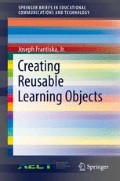Abstract
The modern field of instructional design is like others that are based on high technology—dynamic and progressively complex so there’s always a new concept, procedure or software package coming along. One of the latest concepts to become part of the field is that of learning objects. Associated fields such as software engineering have the related concept of object oriented design and programming. In their text Programming Concepts in Java, J.N. Patterson, Hume and Christine Stephenson define an object as “An object is a set of data and the methods which operate on that data” ( Patterson Hume and Stephenson 1998, p. 11).
Access this chapter
Tax calculation will be finalised at checkout
Purchases are for personal use only
References
Boyle, T. (2006). The design and development of second generation learning objects. In E. Pearson & P. Bohman (Eds.), Proceedings of World Conference on Educational Multimedia, Hypermedia and Telecommunications 2006 (pp. 2–12). Chesapeake, VA: AACE.
Campbell, L. (2003). Interoperability and reusable learning objects. PowerPoint slides from workshop on “Breaking boundaries: Innovation in medical education,” Manchester, UK, February 2003. Retrieved from http://www.medev.ac.uk/docs/breaking_boundaries/campbell_workshop.
Gerard, R. W. (1969). Shaping the mind: Computers in education. In R. C. Atkinson & H. A. Wilson (Eds.), Computer-assisted instruction: A book of readings. New York: Academic Press.
LTSC. (2000). Standards for the learning technology glossary. Working draft, IEEE P1484.3, Learning Technology Standards Committee (LTSC). Retrieved from http://ltsc.ieee.org/doc/.
Patterson Hume, J. N., & Stephenson, C. (1998). Programming concepts in Java. Toronto: Holt Software Associates.
Polsani, P. (2003). Use and abuse of reusable learning objects. Journal of Digital Information, 3(4). Retrieved August 6, 2009, from http://journals.tdl.org/jodi/article/view/89/88.
Author information
Authors and Affiliations
Rights and permissions
Copyright information
© 2016 Springer International Publishing Switzerland
About this chapter
Cite this chapter
Frantiska, J.J. (2016). Background and Significance. In: Creating Reusable Learning Objects. SpringerBriefs in Educational Communications and Technology. Springer, Cham. https://doi.org/10.1007/978-3-319-32889-8_1
Download citation
DOI: https://doi.org/10.1007/978-3-319-32889-8_1
Published:
Publisher Name: Springer, Cham
Print ISBN: 978-3-319-32888-1
Online ISBN: 978-3-319-32889-8
eBook Packages: EducationEducation (R0)

